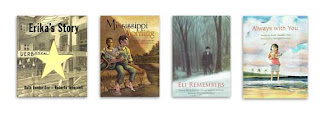Bear Snores On
By Karma Wilson
Illustrated by Jane Chapman
Awards: This wonderful picture book has won 19 awards. ( If I posted them all, you wouldn't have time to read my book review. So please visit these links Bear Snores On and teacher resources.
Synopsis: Amazon.com Review
On a cold windy night, an itty-bitty mouse "pitter-pat, tip-toe, creep-crawls" into a sleeping bear's cozy lair, looking for relief from the bitter winter weather. Soon he is joined by a veritable menagerie of woodland animals, and the party begins. Popping corn, brewing tea, tweeting, and chatting, the critters enjoy themselves thoroughly while the bear slumbers through it all. Until, that is, an errant pepper flake from the simmering stew wakes him up with a giant sneeze. As the bear goes from ferocious snarls and rumbles to pitiful whimpers, his uninvited guests realize what the problem is.
Why I like this book:
Let me just say Karma is amazing at telling a story in rhyme. This book was so much fun to read. I can't say that it is my favorite, because my 2nd graders and I love them all! As a teacher it sparked great vocabulary lessons and was a great piece to to use in my writer's workshop to focus on the craft of vivid verbs.
Critique for Room 502:
My students loved, loved this book. I think some of my enthusiasm wore off on them. If you were to pole my class, and ask the question, who is one of your favorite bear authors, hands down the winner would be Karma Wilson. We are doing a unit on Alaska and studying the bears that live there. The kids connected instantly to the book. Besides bear, their favorite little character was mouse. When we reached the ending, they responded "Karma tricked us".They love it when books end in a surprise way. And Yes they know her by name- I have to take credit for that one- They loved the part when bears thinks they are having a party without him.
I have one little boy who burst into his infectious laugh...which started others to laugh. Yes , I did too! We were having great time on the carpet. They love to read rhyme.
We have a tradition in my classroom when one of the students is absent we sing a wish you well song, sending them love and hope that they will return soon. My little giggler, said "Bear's friends need to sing him, the Wish you well song."so he can feel better. Out of all the books I have in my classroom library, Karma's bear books are the most worn because they love to sit and read them over and over again. For a teacher, this is a beautiful sight. The critics from room 502 give Bear Snores On two thumbs up and a giggle.
You've snuck in my lairNot to worry. Mouse knows just what to do.
and you've all had fun!
But me? I was sleeping
and...
I have had none!
Why I like this book:
Let me just say Karma is amazing at telling a story in rhyme. This book was so much fun to read. I can't say that it is my favorite, because my 2nd graders and I love them all! As a teacher it sparked great vocabulary lessons and was a great piece to to use in my writer's workshop to focus on the craft of vivid verbs.
Critique for Room 502:
My students loved, loved this book. I think some of my enthusiasm wore off on them. If you were to pole my class, and ask the question, who is one of your favorite bear authors, hands down the winner would be Karma Wilson. We are doing a unit on Alaska and studying the bears that live there. The kids connected instantly to the book. Besides bear, their favorite little character was mouse. When we reached the ending, they responded "Karma tricked us".They love it when books end in a surprise way. And Yes they know her by name- I have to take credit for that one- They loved the part when bears thinks they are having a party without him.
I have one little boy who burst into his infectious laugh...which started others to laugh. Yes , I did too! We were having great time on the carpet. They love to read rhyme.
We have a tradition in my classroom when one of the students is absent we sing a wish you well song, sending them love and hope that they will return soon. My little giggler, said "Bear's friends need to sing him, the Wish you well song."so he can feel better. Out of all the books I have in my classroom library, Karma's bear books are the most worn because they love to sit and read them over and over again. For a teacher, this is a beautiful sight. The critics from room 502 give Bear Snores On two thumbs up and a giggle.









